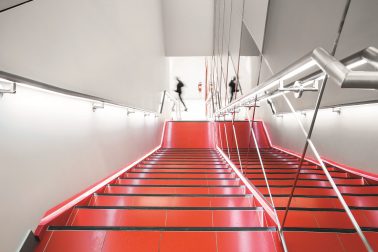How evacuation chairs can save lives
 There are various versions of evacuation chairs, but they are all designed to help people with impaired mobility move up or down a staircase in an emergency. They are most often seen in workplaces or hotels with a cover over the top and often look like they’ve never been used. Evac chairs are signposted by green guidance signs showing a bold pictograph of a person being taken downstairs in a chair.
There are various versions of evacuation chairs, but they are all designed to help people with impaired mobility move up or down a staircase in an emergency. They are most often seen in workplaces or hotels with a cover over the top and often look like they’ve never been used. Evac chairs are signposted by green guidance signs showing a bold pictograph of a person being taken downstairs in a chair.
It’s easy to see evacuation chairs as dust gatherers, but during a fire or similar emergency when the lift cannot be used, they ensure that people with all types of permanent or temporary mobility problems can escape safely along with everyone else.
What are evacuation chairs?
Evacuation chairs can look like a cross between a chair, a stretcher and a wheelchair. A specially designed device is needed because a stretcher is impractical on narrow stairwells and a wheelchair is too heavy to push down a flight of stairs in a way that is safe or comfortable for the person in it.
Evac chairs are much lighter than a standard wheelchair, though they are wheeled and have straps and handles to keep the evacuees secure while being manoeuvred out of the building. Unlike a stretcher, an evac chair allows an evacuee’s weight to be carried mainly by the staircase, rather than the person pushing. Most can manage two stairs at a time to make the process as smooth as possible. They are compact enough to store away on a wall when not in use and simple to assemble by someone who has had minimal training.
On the way down, gravity is a great help for an operator, but what about stopping or climbing stairs if a person needs to leave a basement floor? To give an individual more control, there are evac chairs with powered units that manage movement up or down, and others which have a built-in hydraulic braking system to control the descent.
How do they function in a workplace?
Evacuation chairs are designed to help anyone with a mobility impairment get up or downstairs during an evacuation. The majority are operated by a single person who must be properly trained and allowed to practice using the chair regularly each year.
The potential evacuee will also benefit from joining in with the trial runs. The real thing can be a stressful experience for both people, so learning to manage the situation together can help.
In the event of a real emergency, the dedicated operative should be able to deploy the evac chair very quickly and help the passenger transfer from their wheelchair if necessary. This should take place close to the fire refuge area where people are safe while an evacuation gets underway.
Once the passenger is secured, the correct technique for moving them down or upstairs should be employed. The various designs of chair are used differently and this is why training is so important.
Do I need an evacuation chair?
Evac chairs are not mentioned in the 1995 Disability Discrimination Act, but without having one on the premises, a business could still be breaching this act or the 2010 Equality Act. This is because restricting disabled people’s access to certain areas of the building is mentioned in the legislation. Therefore, as well as putting people’s safety at risk, a workplace that does not provide access for people with impaired mobility is probably not fulfilling its legal obligations.
What are PEEP escape plans?
Any conscientious business takes steps to keep employees safe in the working environment and a reliable evacuation route is essential for every team member. Once an alarm has sounded, people need to be aware of the plan and how to follow it, whether they are able-bodied or not.
Often referred to as a PEEP, Personal Emergency Evacuation Plans are individual plans for people who may need assistance to escape quickly in an emergency. The team members who could need a PEEP or a temporary PEEP include those with:
• Cognitive impairments
• Sight problems
• Limited mobility
• Impaired hearing
• A broken leg
• Asthma
• Late-stage pregnancies
Employees should let their manager know about their need for a PEEP, then work with them to select the best plan for a safe escape.
Conclusion
According to Gov.uk website, around 16% of working adults have a disability and problems with mobility is one of the most common impairments. This means that people who have problems with mobility are by no means a tiny minority. To keep them safe, employers and business owners need to prepare in advance. In buildings with a staircase, one essential way to do this is by ensuring an evac chair is easily accessible in an emergency.
